From small local stores to well-known brands — businesses of all sizes have started selling clothes online. Unlike brick-and-mortar stores, an online clothing business doesn’t require considerable investment and can be easily managed from your own home.
Clothing eCommerce stores are popular, too, with nearly 21% of fashion retail sales happening online.
If you also want to make money by selling clothes online, you need a good strategy and the right platform to start your business.
Here, we walk you through the various platforms you can use to sell clothes online, the steps for starting an eCommerce clothing business and the best practices to ensure you start with the right foot.
But first, let’s see how profitable online clothing businesses are.
Is selling clothes online profitable?
The fashion eCommerce industry is growing at a quick pace. The market is expected to reach a whopping $1.2 trillion by 2027.
Due to this growth, many online clothing stores have popped up in the last few years, making the market feel cluttered. However, the demand for fashion eCommerce also continues to grow.
Whether it’s a homegrown clothing business or a large brand website — people love shopping online for clothes due to the convenience and variety it offers. That makes selling clothes online a profitable venture.
In the U.S., online clothing store owners earn more than $32,000 per year on average.
However, starting an eCommerce store isn’t just profitable in terms of revenue. The investments in selling clothes online are much less than in a brick-and-mortar store.
For example, you don’t need to pay rent or maintenance of property for an online clothing store. The cost of selling on a platform or building a website is minimal compared to the price of real estate.
Moreover, there are various business models, like dropshipping, that you can conveniently use with an online business. That helps you save inventory costs, especially if you are a beginner.
These financial benefits make an online fashion store an appealing option for budding entrepreneurs. However, before you start this business, you need a suitable platform that helps you set up a successful clothing shop.
Where to sell clothes online
When you’re building an online apparel business, there are multiple platforms you can choose from. Some options are easier and more suitable for new business owners, while others might require more effort.
Here’s an overview of the various platforms where you can sell clothes and make a profit:
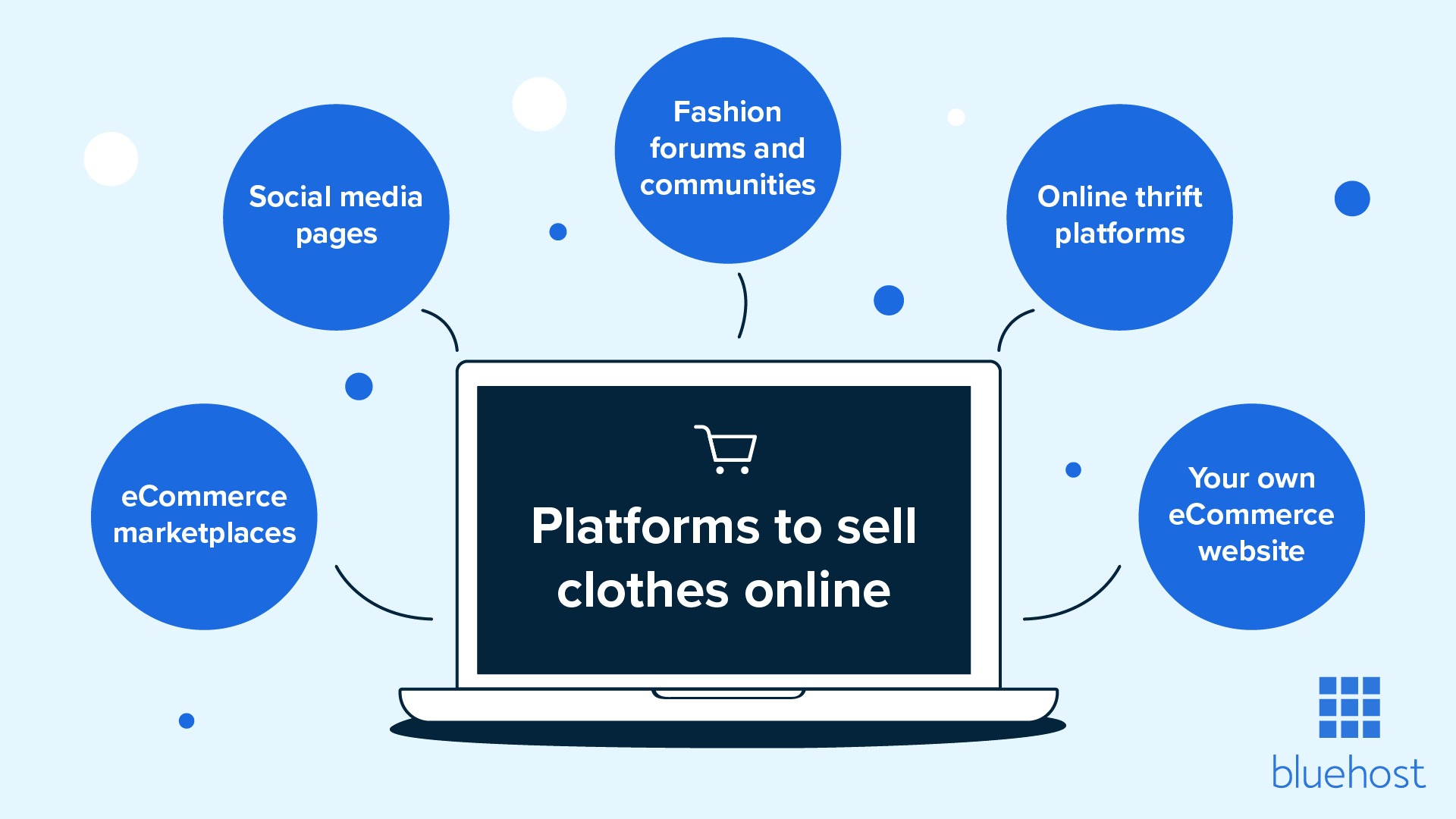
eCommerce marketplaces
Online marketplaces like Amazon, eBay and Etsy are great platforms for businesses of any size. Whether you sell a single sweater or have multiple clothing lines, you can easily start a business by signing up and listing the products on eCommerce marketplaces.
As some of these platforms are popular and trustworthy, you can tap into their existing customer base. However, you’ll still need to extensively market the products and maintain good customer reviews to get a high sales volume.
Your products will also be listed along with hundreds of other competitors, making it hard to stand out.
Moreover, eCommerce platforms take a cut out of every sale in terms of processing fees, selling fees, and fulfillment charges. For example, the charges for selling on Amazon may total up to 50% of your revenue.
That makes it hard to run a profitable clothing business, especially if you can’t invest too much.
Social media pages
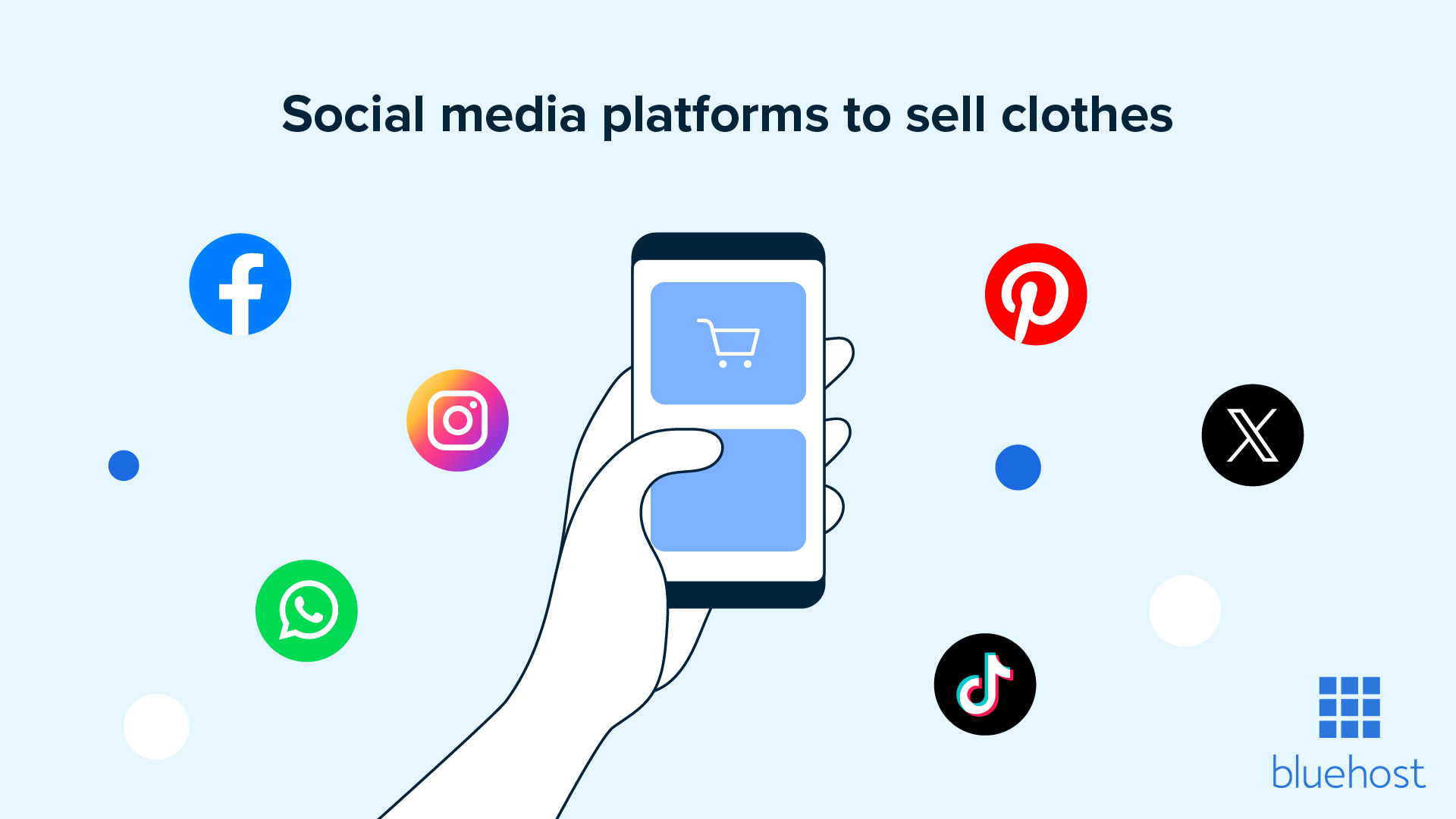
Social media pages are one of the most popular ways to sell clothes online. Many small businesses convert their profile into their product page as selling on social media offers several conveniences, such as:
- Free usage: On most platforms like Facebook Marketplace and Instagram, creating an account and uploading content requires no investment.
- Access to various customer groups: Social media gives you access to its large user base. The total number of social media users in 2023 is estimated to be 4.89 billion.
- No revenue cuts: These platforms don’t charge any transaction or commission fees, and business owners can keep 100% of the revenue generated through social media sales.
However, due to the perks and the ease of building a social media page, the competition on these websites is huge.
Also, there are no inbuilt options for sales, such as placing orders or making payments. You’ll have to complete the sales processes manually or automate them, which requires considerable investment.
Fashion forums and communities
Communities related to fashion are an alternate way to use social media to sell clothes online. You’ll find several groups of fashion enthusiasts on platforms like Facebook and WhatsApp.
You can join these groups to discuss, promote and sell your products. However, like a social media page, you’ll need to manage the sales process manually.
Your reach will also be limited to the members of the group, so there’s little room to scale the business. Multiple competitors in the group targeting the same audience might also impact your revenue.
Online thrift platforms
Thrifting is a great way to support sustainability by recycling used clothes while earning a profit. If you’re interested in becoming a reseller of secondhand clothes and accessories, you can try out platforms like:
- Poshmark
- Mercari
- The RealReal
- Vinted
- thredUP
- Depop
From preowned apparel from designer brands like Gucci or Louis Vuitton to old clothes from your own wardrobe — you can sell anything at an online thrift store. But these platforms are usually made for one-time sales and establishing yourself as a brand is difficult.
Even if you want to start a business by selling unwanted clothes, these websites take a cut similar to eCommerce platforms. For example, Poshmark takes a 20% commission on all sales above $15.
As you are already reselling used items at a lower price, the additional fees considerably decrease your revenue.
Your own eCommerce website
Compared to all the other options, building your own eCommerce website is a better choice to sell clothes online. An eCommerce website offers you the flexibility and recognition every apparel business requires.
By selling clothing through your own website, you can stand out among apparel companies by establishing your own brand. You won’t be paying a commission or listing your products with competitors, which means higher revenue potential and independent financial decisions.
Many budding entrepreneurs are skeptical of choosing the website route as they assume it costs a lot. In reality, building your own clothing website won’t burn a hole in your pocket.
Platforms like WordPress simplify website building and make it economical. In addition, service providers like Bluehost help you launch your own eCommerce store with budget-friendly website plans.
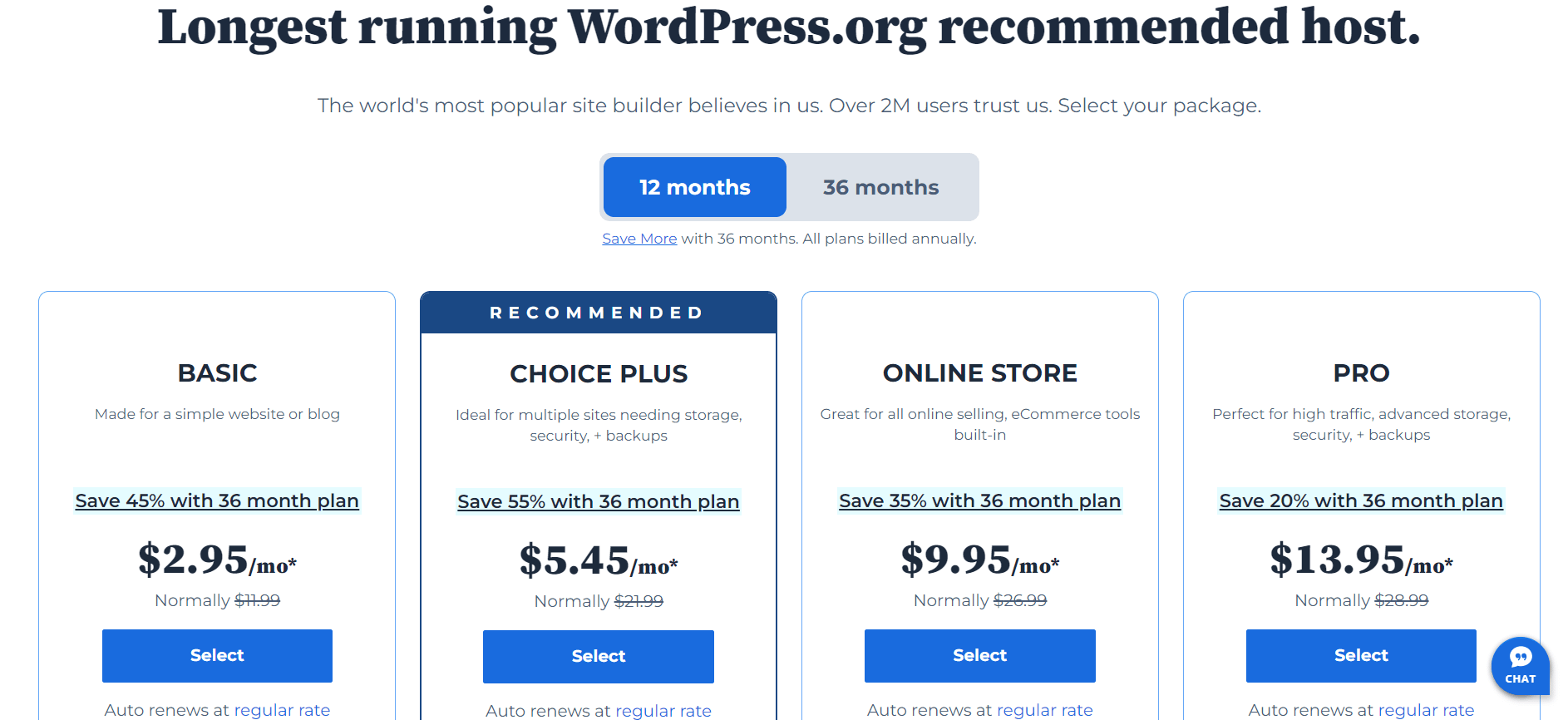
With Bluehost’s online selling website plan, creating and maintaining an online clothing website costs only $9.95/month. It also includes the eCommerce tools, WP themes and website analytics required to run an online store.
In addition, you’ll incur some more costs like marketing, inventory and shipping. However, these are standard expenses you’ll incur, irrespective of the platform you choose.
While each platform has its merits and demerits, it’s best to build your own website if you want to establish yourself as a brand. But before you start the website-building process, let’s learn about the important steps to starting an online clothing business.
Steps to starting an online clothing business
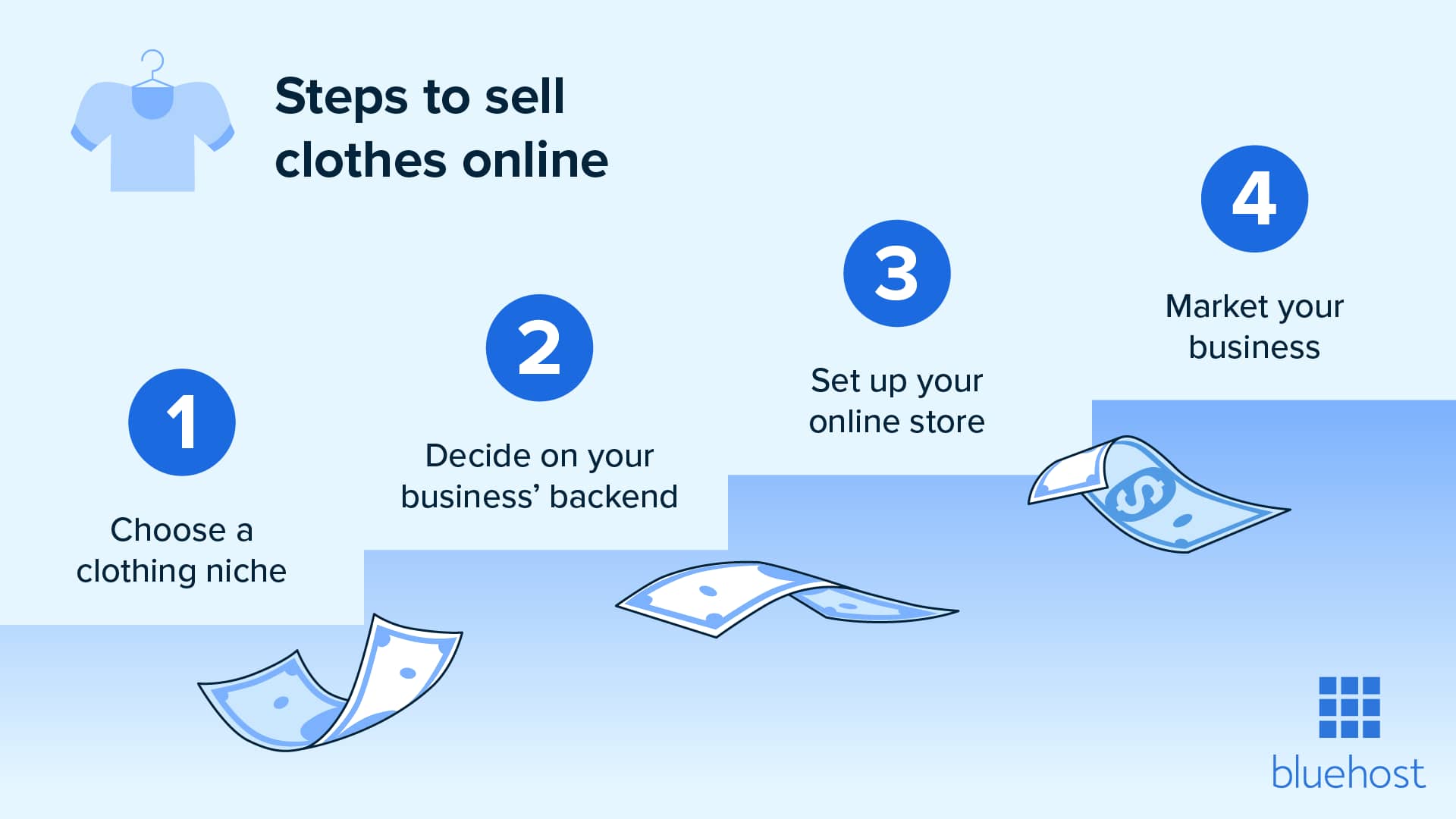
Having a step-by-step plan for starting your clothing store helps you calculate the budget, decide on the product catalog and have a clear business goal. Here’s how you can get started with your online apparel shop:
1. Choose a clothing niche
Your clothing niche narrows down the type of products you sell in your online store. You can select from thousands of clothing types (e.g., women’s wear, loungewear or designer clothing).
Here are a few examples of clothing niches:
- By target audience: Kidswear, men’s, onesies for babies.
- By purpose: Winter coats, sportswear, maternity clothes, athleisure sets.
- By clothing items: Oversized t-shirts, denim pants, everyday handbags.
- By source: Sustainable clothing, organic fabrics, vintage clothing.
To choose a niche, conduct global and local market research to understand what type of clothes are in demand. Also, define your target audience and study competitor’s products to determine what their customers like and assess the market gap.
For example, you can check competitor websites to know what is frequently out of stock and assess the demand for those products. Or you can check social media comments and posts to learn what type of clothing is trending.
You can also use tools like Google Trends or Social Sprout to discover what kinds of clothing people are searching for or talking about.
2. Decide on your business’ backend
An eCommerce clothing store’s backend can be broadly divided into two parts: inventory and shipping. Choosing the vendors for these processes beforehand ensures that your business runs hassle-free.
Inventory
You have several options when deciding on your apparel store’s inventory. You can either design clothes by yourself, buy from a seller or resell preowned clothing.
If you choose to make your own clothes, enlist multiple vendors for raw materials like fabric, lace, threads and embellishments. If you want to buy from a seller, look for trusted vendors that deliver both variety and quality in your chosen niche.
For preowned clothing, you can go through your own wardrobe, ask friends and family to contribute or also look for clothing pieces at the local thrift store.
All the above options require some amount of investment for inventory management. If you don’t want to spend much on inventory, opt for the dropshipping business model.
In dropshipping, the seller is directly responsible for product fulfillment, while you are responsible for marketing and sales. You don’t need to maintain any inventory and will still earn a profit for every sale made through your website.
Shipping and fulfillment
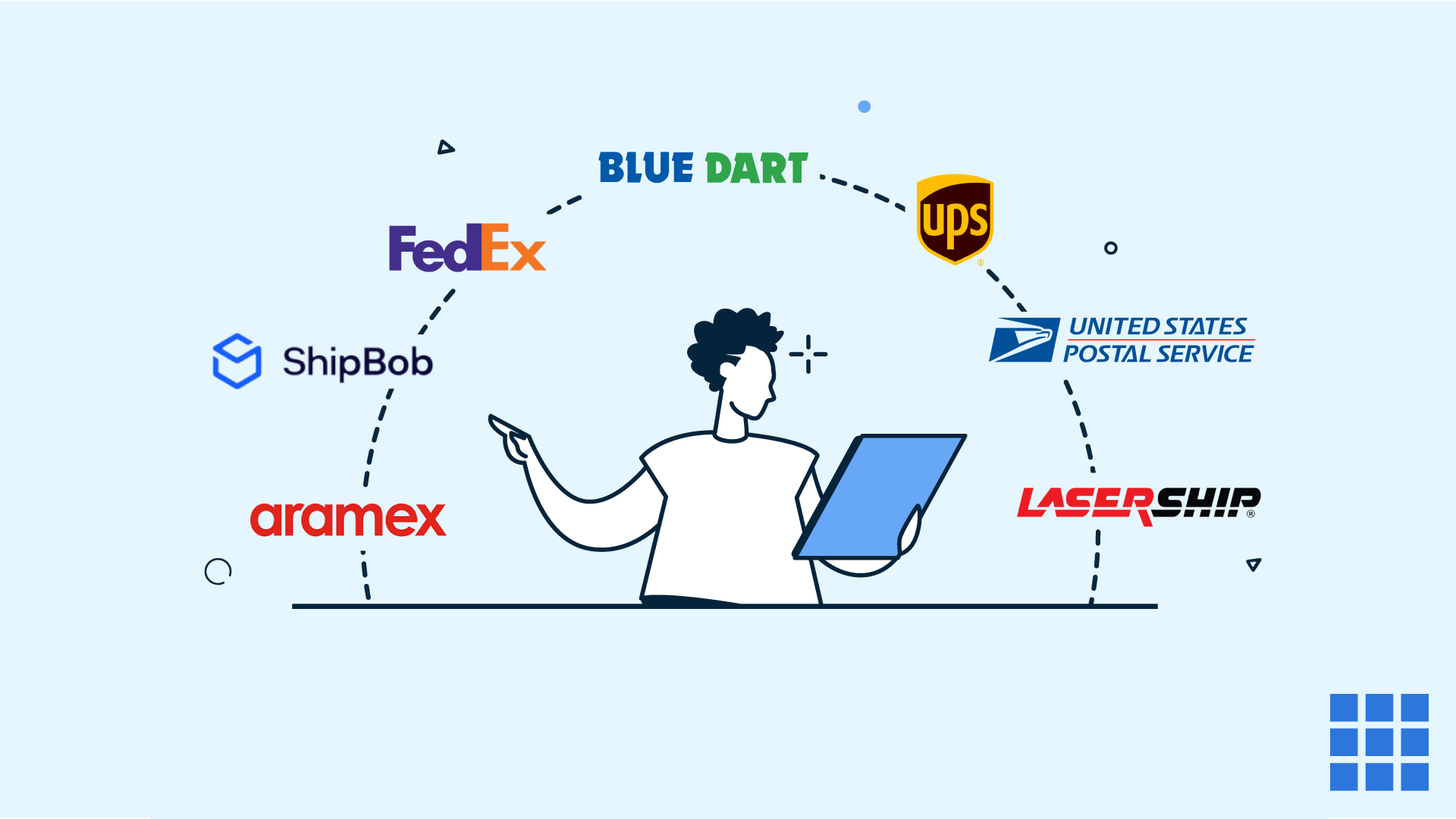
There are several companies in the U.S., such as USPS and FedEx, that are good for eCommerce shipping. However, each company has different charges, which also vary based on location.
When choosing a third-party fulfillment partner, compare various options based on the pricing, convenience and quality of service. Depending on your requirements, you can also choose multiple vendors to deliver your online consignments.
For example, if a customer wants an order quickly, you can use the priority mail express service at your local post office while using a different shipping company for usual deliveries.
Regardless of the shipping partner you choose, you’ll need to provide good packaging to ensure the products reach the customers safely.
That includes using high-quality packaging material, sealing the parcels properly and sticking prepaid shipping labels with the right customer details.
3. Set up your online store
Once you’ve set up the backend processes, you can get started with creating your eCommerce clothing website. If you’re working with WordPress or WooCommerce, choose Bluehost to simplify website-building for you.
With Bluehost, you can build online stores with WordPress hosting at affordable prices. You also get access to numerous plugins like YITH and Jetpack to enhance your eCommerce website.
After building your website, start setting up your online store. That includes processes such as:
- Uploading product images. Create high-quality images of the clothing collection and upload at least three images of each product on your website. The pictures should be taken in natural light to clearly show the color, style and details of the clothing items.
- Deciding product pricing. The product’s selling price should be higher than the original cost and accommodate expenses such as shipping costs and inventory management charges.
- Making the website SEO-friendly. Give detailed descriptions of products and include popular keywords to improve your eCommerce website’s SEO and help the store rank high in SERPs.
- Implementing necessary plugins. Use plugins that help you simplify sales processes like order placement and confirmation and connect your website to payment gateways like PayPal and Stripe.
4. Market your business
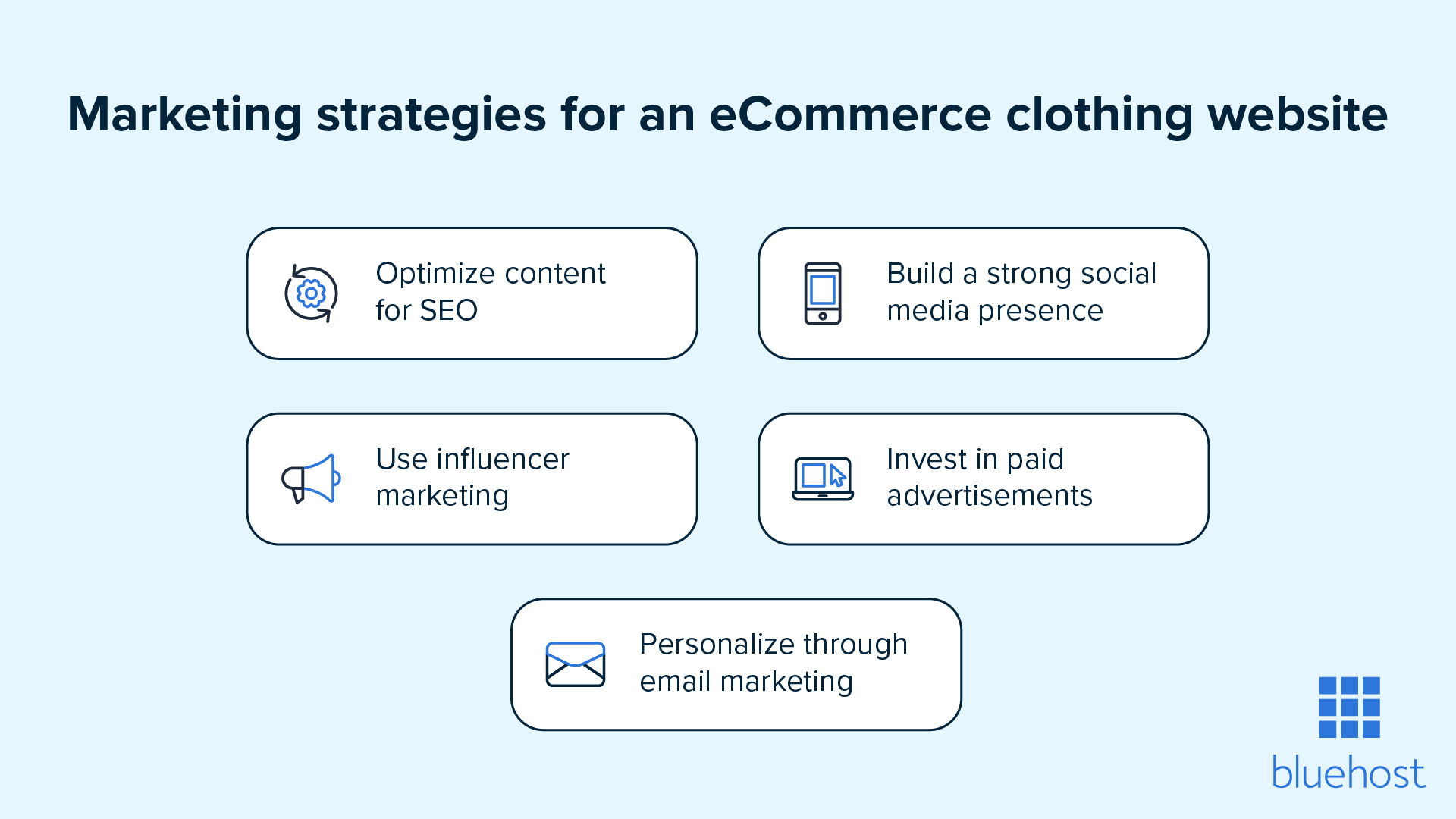
Marketing your business helps attract more customers to your online clothing store. If you don’t want to invest much in paid advertising initially, there are several free online marketing strategies you can try out.
Start by optimizing your website for search engines. An SEO-friendly website ranks higher on SERPs, attracts more organic traffic and brings in more sales.
Also, promote your brand on social media by creating a page and uploading images, posts, reels and other content. That improves engagement and boosts social media following.
Redirect these followers to your brand’s website through your posts or by offering exclusive discounts and giveaways. You can also use social media to connect with influencers who can purchase and promote your products.
Once your business gains some traction, invest in marketing strategies like paid ads, sponsorships and promotions. Start loyalty and referral programs to retain existing customers and gain new ones through word-of-mouth.
The above steps help you create an eCommerce website for selling clothes online. But if you want to stand out among competing businesses, follow some of the below best practices for an online apparel business.
Best practices for selling clothes online
Here are some tips to build a successful eCommerce apparel business as a beginner:
- Start small. Keep your initial product range and inventory investments minimal. Stock up a few pieces of each product and increase your inventory as you understand the demand around each item. Otherwise, it may lead to overstocking of products that your customers don’t really like.
- Keep up with the trends. Trends in the fashion industry change quickly, with most of them lasting for two to four months. If you want to stay relevant, periodically update your product catalog with items that are in demand for that season.
- Organize your online store. An organized eCommerce website is more attractive and helps customers easily navigate and find the products they require. Use intuitive navigation tools, create menus and categories for different products and declutter the website by removing outdated listings.
- Use secure payment methods. Ensure that you use trusted payment gateways to keep both the customers and your own money safe. Provide multiple payment options such as debit cards, e-wallets and online money transfers to help customers easily pay for their orders.
Final thoughts: How to sell clothes online and make money
Selling clothes online is a lucrative idea for anyone wanting to start an eCommerce business. However, choosing the right platform is also essential to keeping the business profitable and scalable.
Building a website gives you the cost-benefit and autonomy of establishing your clothing brand with minimal investments.
Connect with a reliable service provider like Bluehost to create your eCommerce clothing website. Bluehost handles everything from website-building to hosting so you can focus on important sales processes and be worry-free about website maintenance.
Want to build a profitable clothing business online? Check out the Websites and Online Stores by Bluehost.
FAQs for selling clothes online
The best platform to sell clothes online is your own website. While other options, such as social media and eCommerce marketplaces, exist, they are highly competitive or take significant commissions from the seller’s revenue.
With an eCommerce website, you can establish a clothing brand and make independent financial decisions without directly listing your products among competitors.
Yes. There are many websites, such as Poshmark, Vinted and Depop, that help you sell pre-owned clothes. You can also create social media thrift pages to attract an audience interested in recycling and sustainability.
To sell clothes through your own website, start by uploading high-quality product images and descriptions. Use plugins to add eCommerce functionality like order placement and payments to your website.
Make your website SEO-friendly to get organic traffic by ranking higher in SERPs. Once you generate considerable revenue, invest in paid advertising to attract more customers.
Use marketing strategies like SEO, content marketing and building a social media presence. These methods require little to no investment and are suitable for beginners.
You can also use paid advertising channels such as influencer marketing, social media ad slots and affiliate marketing to further boost sales.
The post How To Sell Clothes Online and Make Money appeared first on Bluehost Blog.
[ad_2]
Article link
